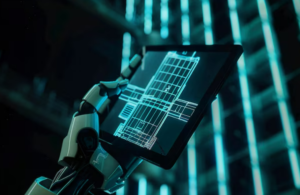Introduction
In the world of today, VFX, animation, and architectural visualization are very crucial, while among the creative phases, one of the biggest problems is rendering, because it is expensive, complicated to handle, and requires enormous power. Rendering is the process that turns 3D models, scenes, and animations into images or video, and it’s something that requires immense computational power. For independent artists, small studios, or designers, such access can be prohibitively expensive, either in the cost of hardware or expensive third-party rendering services.
In rendering, these graphics processing units (GPU) play a critical role since they are designed to handle huge volumes of data for the production of high-detail 3D graphics and animations. Since they are unlike the CPU, which can only do general computing, they are ones that lead in parallel processing, which is quite ideal for most rendering-related activities, including shading, lighting, texture mapping, and even more complex visual effects.
Rendering is computationally very challenging and can be broadly categorized into two types: real-time rendering and offline rendering. Real time rendering is used in video games and virtual reality applications, where high frame-rates ordinarily 60 FPS or even higher must be rendered and shown for the performance to be smooth. For this reason, powerful GPUs like the NVIDIA GeForce RTX series are highly preferred for smooth and fast resolutions, complex lighting effects like ray tracing, and fast rendering of frames.
Like offline rendering, which is used for film production, architecture, and animation, such a process requires much more power from the GPU because the details are finer and more precise. This process need not be instantaneous but generates photorealistic images. For such work, high-end GPUs, such as the NVIDIA RTX A6000 or Tesla series, are normally used since they provide tremendous amounts of memory, higher CUDA cores, and dedicated rendering features that help in detailing details frame by frame.
The Render Token (RNDR) seeks to address such a problem, providing a decentralized and affordable means of enabling creators to tap into available rendering power. Render Token directly connects artists to available GPU resources on a blockchain-based network, thus becoming more accessible to people who could not afford their services previously while using traditional rendering.
Concern: Expensive and Inaccessible Rendering Power
Rendering is an extremely time-consuming activity, especially for the highest output quality in industries such as VFX, animation, and architectural visualization. Handling movie productions in Hollywood, AAA games, or immersive VR environments require hours of rendering on powerful GPUs. However, with the need for high output quality not limited to major studios, small businesses, freelancers, and independent artists have to render intricate projects on behalf of their clients or as part of their portfolio.
The problems the architecture discipline faces in rendering result from large-scale models, detailed ornaments, and the demand for photorealism. Related software in combating these problems is V-Ray, Lumion, and Unity Engine. V-Ray boasts highly advanced lighting and materials, but it becomes slow unless there are highly powerful GPUs, especially in relation to high-resolution images. Lumion boasts faster real-time rendering but fails to handle very detailed scenes well. Hence, the Unity Engine is used for generally interactive 3D experiences and heavily uses GPU resources to help give smooth real-time walkthroughs, especially in large architectural visualizations or virtual reality applications.
The problem is that it often comes with a hefty price. High-end GPUs essential for the process can run into thousands of dollars. Not to forget, assigning the rendering to agencies or cloud services can get quite cost-prohibitive, especially for smaller creators working off shoestring budgets. Many then find this to be a major blockade when advancing their careers, such as having the ability to create work at top-tier levels or contesting against greater studios.
On the other side, however, there are people and organizations that sit idle on their GPU power, whether from personal gaming setups or unused computing resources. This, undoubtedly, represents mostly untapped opportunities.
The Solution: Render Token’s Decentralized GPU Network
Render Token solves this problem by creating a distributed rendering network based on blockchain technology. It connects two different groups of users.
Jules Urbach, founder and CEO of OTOY developed Render Token- a cloud graphics pioneer. For several years, OTOY has been at the edge of developing state-of-the-art rendering solutions. It includes the industry-leading rendering software Octane Render for film, gaming, and virtual reality industries.
The creators who need relatively cheap, high-performance GPU power to render their projects.
Users with free GPU resources and who are ready to lease them, often referred to as GPU miners.
The system, as can be interpreted from the above, Render Token establishes a decentralized marketplace for the rendering power over the GPU. Here is how it works.
Submission of Tasks
A creator submits his rendering task into the Render Network. It can be anything, from complex 3D animation to short film visual effects for a game or architectural walkthrough.
Task Creation
The designers implement their designs using software like Blender, Cinema 4D or Autodesk Maya. A software already has these Render Network plugins or tools which are pre-installed in order to make submitting easier.
When the 3D model or animation is done, the creators export their project file in any format supported by the Render Network, such as OBJ or FBX.
Task Submission
The creators visit the website of Render Network or connect the web interface to a 3D designing software so that they can upload their project files and give the requirements for rendering, such as resolution, frame rate, lighting settings, and other preferences.
The platform breaks the task of rendering into smaller tasks to be performed by the distributed GPUs in the network.
Estimate and Payment
Render Token Price Prediction (2024/2025/2030)
The system calculates an estimate of the frame costs to be rendered based on the task, number of frames and availability of GPU.
Creators pay for rendering services with Render Tokens (RNDR), which will need to be used to initiate the job. The amount of RNDR tokens required is shown just before the submission is confirmed.
Assignment to Miners
Then the task will be issued to GPU owners in the network who can lease out their resources to process the assigned task. These GPU owners could even be the large data centers or individuals having powerful rigs that lie idle, such as high-end gaming rigs.
Task Distribution
The moment that the payment is cleared, the job is spread throughout the Render Network, open source, where groups of miners with numerous GPUs work to render the frames or chunks of the project.
Secure and Decentralized Transactions
Blockchain Network
The Render Token, RNDR, operates on the Ethereum blockchain, which is decentralized in its structure and relies on smart contracts. The Ethereum blockchain network ensures that transactions, such as the compensation for rendering jobs and rewards for GPU providers, are secure and settled.
Centralized vs. Decentralized Rendering Networks
Wallet Connections
- In order to hold and conduct transfers of RNDR tokens, creators need to hold an Ethereum-compatible wallet. Examples include:
- MetaMask is one of the most popular Ethereum wallets and interacts seamlessly with any Apps.
- Trust Wallet: This is another Ethereum wallet that lets you manage RNDR transactions.
Connect your wallet
- Download a wallet extension such as MetaMask and install it or download the Trust Wallet mobile wallet app
- Buy RNDR tokens on the crypto exchange, or work for your tokens by participating in the Render Network.
- Using the platform during the upload process of a rendering job, it will ask you to connect your wallet for it to initiate the payment for the rendering of the jobs.
Render Token vs. Traditional Rendering Services
Traditional rendering services tend to be quite pricey, whether using cloud-based services or third-party agencies. Large studios-or “rendering farms”charge a premium for access to their high-performance GPUs and tend to be out of reach for independent creators or small studios.
Render Token approaches the pricing issue in a more economic manner, built upon the decentralization of the distributed network of available GPUs. It somehow reduces the cost of rendering without any decline in performance. As those who create have access to the needed GPU and pay only for what is used, the pricing turns out to be more elastic and scalable depending on the size and complexity of the project.
Secondly, Render Token decentralization makes it scalable and able to meet the increasing high demand for rendering services that range from VFX, animation, gaming, and architecture.
Application of Render Token in VFX, Animation, and Architecture
There exists a huge demand for high-quality rendering in all forms in diversified sectors. Here’s how Render Token is meeting the unique needs of three mammoth areas:
Visual effects and animation is a high resource field. It takes hours, even days, to render scenes for films, advertisements or video games with traditional methods. Render Token offers artists and animators the needed GPU power in a fraction of the cost and allows them to produce quality visuals they need without the possibility of overrunning on hardware.
Architecture
In architectural visualization, it is paramount to render realistic models of buildings, interiors, and landscapes. This would help designers and clients fully understand their project. Architects widely rely on rendering to present their designs, and high quality renders are necessary in presentation and marketing. As a result, architects will now be able to render their 3D models faster and cheaper with Render Token, thereby improving the productivity level and lowering costs for their entire process.
Gaming and Virtual Reality
Game developers and virtual reality developers rely on powerful GPUs to render very lifelike, very detailed 3D environments. Render Token gives those creators distributed GPU power which they use to create more complex and immersive worlds whether game or VR experience without having to invest too much in the structure.
The Future of Render Token
The growing demand for real-time rendering and high-quality visual content, plus the number of potential consumers who would be creators from various industries, suggests that the decentralized Render Token network may become standard for creators. Another trend that enhances the potential of the Render Token is the integration of AI and machine learning technologies with rendering services.
Render Token’s latest collaborations only show its intent and dedication toward evolution and expansion in services. As power becomes an increasingly important factor in the world of GPUs, specifically related to rendering; for example, artificial intelligence-based content development or the metaverse, Render Token appears ready to break into the services market for creators at an affordable, scalable, and accessible level.
Conclusion
Render Token is not only another blockchain project; it’s an answer to a real issue faced by artists, animators, architects, and many other global creators. In the sense in which it democratizes access to GPU rendering power through decentralized networks, it stands against the high costs and unavailability of traditional rendering services brought about by the same services, thus allowing for smaller creators competing with studios from all over the world without this problem standing in their way.
Since visual elements play such a central role in the ever-visual world of a modern society, the Render Token provides a very practical, effective, and yet affordable solution to empower creators to breathe life into their visions.






